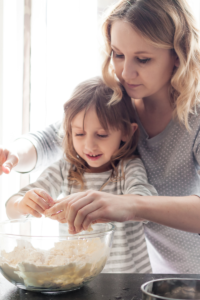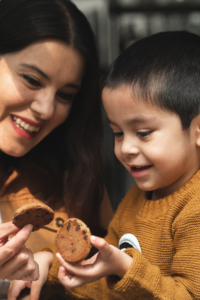Your Guide to Positive Discipline: Raising Good Humans Without Punishment
Updated June 2024

Many parents face a misalignment between parenting and discipline: we desire well-behaved, respectful, and responsible children. However, we don’t actually teach them these behaviors. It’s easy to fall into the trap of punishment without guidance.
Think of it this way:
Let’s say your child is learning to ride a bike – a process filled with wobbly starts and inevitable falls. Yet, instead of being there to dust them off and offer encouragement, support, and guidance – every time they fall, you send them to their room for a timeout. Your child will go to their room feeling defeated, deflated, and disconnected from you. And one thing is for certain – they will not learn how to ride a bike this way.
The same principle applies to behavior. Young children (ages 2-7) are still developing their understanding of the world and how to navigate it appropriately. Expecting them to instinctively make “good choices” without guidance is unrealistic and unfair.
Positive discipline offers a transformative approach. It goes beyond simply demanding obedience and focuses on teaching, empowering, and building a strong connection with your child. Positive discipline prioritizes kindness, empathy, and understanding, helping children learn valuable life skills and develop self-control.
The Benefits of Positive Discipline

Positive discipline is an investment in your child’s future. It empowers them to develop valuable life skills such as problem-solving, conflict resolution, self-regulation, and social skills. It also fosters a strong parent-child bond built on trust, empathy, and respect. These benefits will continue to grow with your child, shaping them into kind, confident, and responsible individuals. Here are some other benefits of positive discipline:
- Empowers Kids to Solve Problems: Positive discipline teaches children valuable skills to navigate challenges and find solutions independently.
- Boosts Confidence and Self-Esteem: By acknowledging their efforts and celebrating their achievements, positive discipline fosters a strong sense of self-worth and confidence in children.
- Motivates and Encourages Positive Choices: Positive reinforcement and guidance inspire children to make good choices and strive to do their best.
- Strengthens Parent-Child Connection: Positive discipline fosters a loving and supportive environment, building trust and a strong bond between parent and child.
- Models Kindness and Emotional Intelligence: Through positive interactions, parents become role models, teaching their children valuable social and emotional skills.
Putting Positive Discipline into Action: A Guide for Parents
Positive discipline goes beyond simply stopping bad behavior. It’s about teaching, guiding, and empowering your child to make good choices, fostering a strong connection, and building essential life skills. Here are some key strategies to implement positive discipline at home:

Be a Positive Role Model:
Children learn best by observing and imitating. Model the behaviors and values you want them to adopt, such as kindness, empathy, and respect. This includes demonstrating how to handle mistakes with grace and learning from them.
Set Clear Expectations and Limits:
Establish clear and age-appropriate rules and expectations for your child. Explain the reason behind rules, and the consequences of rules being broken. Be consistent in enforcing these limits.
One of my favorite ways to ensure consequences are clear is by using this phrase: “If you choose _____, then you choose _____.” For example, “If you choose to draw on anything other than paper, you choose to put your crayons away for the day.”
Now let’s take this a step further. Let’s say you catch your child drawing on the wall with their crayons. There’s no need to yell or punish them, you just calmly need to enforce the consequence. “I noticed you drew on the wall instead of on your paper. That means we’ll put your crayons away for the day. You can try again tomorrow. Let’s get a rag to clean up the wall.”
Focus on Solutions, Not Just Consequences:
When your child makes a mistake, focus on finding solutions together. This teaches them problem-solving skills and helps them see the natural consequences of their actions. As in the example above, your suggestion to get a rag and clean up the wall together is the solution.
When you focus on solutions, you avoid shaming or blaming your child – which is unhelpful and ineffective. Instead, you teach your child to take accountability and problem-solve to make it right.
Offer Choices Whenever Possible:

Empower your child by offering age-appropriate choices whenever possible. This gives them a sense of control and encourages them to make positive decisions. Offering choices allows them to practice making small decisions, preparing them for bigger ones down the road. They learn to evaluate options and make informed choices.
Remember, you’re still in control! The choices you provide should be options you’re comfortable with. This isn’t about ultimatums, but about offering control within boundaries. For example, instead of “Do you want to eat vegetables or no vegetables?” try “Would you like carrots or broccoli with dinner?”
Positive Reinforcement:
My favorite form of positive discipline is positive reinforcement. This is when you catch your child “being good” and acknowledge their positive behaviors.
Here are some examples: “I noticed you cleared your plate without me asking, thank you! That was such a big help.” “I see you’re using your walking feet by the pool. What a good, safe choice!” “Wow, that was so kind of you to share your toy with your friend. I bet that made her feel so happy.”

By highlighting the positive things you notice, you are reinforcing those behaviors, making your child more likely to repeat them. It also strengthens your parent-child bond. When you actively look for your child’s positive behaviors – their helpfulness, kindness, resilience, patience – your focus shifts. You stop solely focusing on correcting the negative or unwanted behaviors. For this reason, parenting becomes a more joyful and fulfilling experience for both you and your child.
Pick Your Battles:
Positive discipline isn’t about micromanaging every behavior. Picking your battles is key to a more fulfilling parenting journey. Here’s a simple rule of thumb: If you don’t have a clear and reasonable explanation for saying “no,” consider saying “yes” instead.
For instance, imagine your child asks to jump in a mud puddle. Is there a safety hazard involved? Are they wearing clothes that can get ruined? If not, let them explore! The joy of discovery and getting a little messy can be a valuable learning experience – it’s worth the ‘yes!’
Be Realistic:
Understanding your child’s developmental stage is key. Don’t make your expectations unachievable for your young child, you’re setting you both up to fail. Tailor expectations and rules accordingly. Here are some common unrealistic expectations parents may have of their young children:
- Sitting Still for Long Periods: Expecting them to sit still for extended periods during meals, car rides, or quiet activities is unrealistic.
- Focusing for Long Durations: Their attention spans are still developing. They might be able to focus on an engaging activity for 5-15 minutes, but expecting them to concentrate on a single task for much longer is unrealistic.
- Impulse Control: The prefrontal cortex, the part of the brain responsible for impulse control, is still under development in young children. They may struggle to resist grabbing toys, interrupting conversations, or blurting things out.
- Managing Tantrums: Tantrums are a normal and common way for young children to express strong emotions. Expecting them to manage emotions or reason through a tantrum is unrealistic.
- Sharing: It can take until children are 7 or 8 years old to fully understand the concept or sharing. Their sense of self and possession is still forming, so you should not expect them to share. Here’s a tip: Focus on taking turns instead! “Right now it’s your sister’s turn with that toy. When she’s done, it will be your turn.”
- Following Instructions: Keep instructions simple and direct. Long-winded explanations or multi-step commands will likely be confusing or overwhelming.
- Perfect Behavior in Public: Public outings can be stimulating and overwhelming for young children. Expecting perfect behavior in stores, restaurants, or other public settings is unrealistic.
These are just a few key strategies to get you started with positive discipline. Remember, it’s a journey, not a destination. As your child grows and develops, so too will your approach to positive discipline. The key is to be flexible, consistent, and most importantly, patient.

A Journey of Growth and Connection
Positive discipline is a journey of growth and connection for both you and your child. It requires patience, consistency, and a willingness to learn alongside them. But the rewards are truly significant. By focusing on teaching, guiding, and building trust, you’ll be well on your way to raising kind, compassionate, and responsible young humans – all without resorting to punishment.
READY TO UNLOCK THE SECRETS OF POSITIVE PARENTING AND TURN TANTRUMS INTO TEAMWORK?
- Download your FREE guide: The Power of Positive Parenting
- Explore the transformative resources in my Positive Parenting shop!
- Follow me on Instagram @ThatQuietMom for daily parenting tips and tricks!





